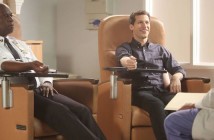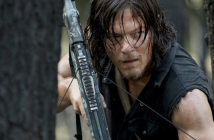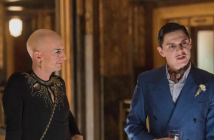9/2/2014, 9:00 pm (EST), HBO
Near the end of this week’s episode of True Detective, we see Rust board a riverboat that slips silently out into the night, into a darkness we can’t even imagine. It feels almost as if we’re watching a scene from Apocalypse Now, that Rust is Captain Willard traveling deeper and deeper into enemy terrain. But Rust isn’t Willard, not really. Rust is Colonel Kurtz, the broken husk of a man preaching his gospel to a world that won’t ever hear it. And he isn’t journeying into that jungle, searching out his prey. No, he’s the predator, back, finally, on his home turf.
“Who Goes There.” The title of this episode is not a question, because what we discover this week is an answer. It is impossible to talk about this week’s episode without discussing the six-minute tracking shot that serves as it’s conclusion. Director Cary Fukunaga has been doing great work all season, but this may just be the crowning achievement. The shot works because it plunges us completely into Rust’s world. For four episodes, we have watched him spout his bleak philosophy, both in 1995 and in 2012. We have seen him hint at the horrors in his past, but all of that was just talk if not for the haunted look behind his eyes. Tonight, in this sequence, we see the chaos Rust speaks of unleashed, and the horrors he’s witnessed become suddenly, shockingly visceral.
The deeper we get into this season, the deeper we travel into the jungle, the more the lines begin to blur. Rust and Marty were coworkers who didn’t particularly like each other just last week. Now they are roommates, saving each other’s lives. They were cops trying to protect the world from bad men. Now they are working outside the law, causing chaos as much as restraining it. The terrifying weapons that the drug dealers’ wield in that final firefight look a whole lot like the ones Rust keeps in that box in his apartment. These men are getting pushed further into the darkness. Or so it seems.
But just who is really doing the pushing? The Captain wants them off the case, the task force is willing to take it from them, no one seems to miss Dora Lang all that much. It is easy for our heroes to imagine that their quest for justice is just forcing them to cross lines they otherwise neatly administer, but it isn’t. These are men who fancy themselves as policing the line between light and darkness, but increasingly, they are more preoccupied with the darkness. Rust has always found a black romance to his own misanthropy, a dark allure to viewing the world as a cesspool he subsists in until someone snuffs him out. Marty, on the other hand, liked to bury his darkness down deep. He focused on his family, on his job, on what it means to be a husband and a father and a man. He had a finely regimented code that meant keeping himself penned up in the light. But with his wife and children gone, he is increasingly seeing his code as the mask it was, and finding himself pulled further and further away from the light.
Part of Rust is reassuming a role over the course of this episode. But part of him is just finally letting go again, unshackling himself from the bonds of civilized society. There’s a certain tenor of post-apocalypse in the scenes with the Iron Crusaders, who discuss living the “outlaw life” and relish living without rules. Rust sees society decaying all around him, so it isn’t hard to imagine he sympathizes with men who have chosen to fall out of it entirely. Generally, Rust plays by rules he doesn’t even really believe in, but in “Who Goes There,” he gives in to the only thing that makes sense to him: anarchy.
Once that tracking shot is over, we cut to a helicopter shot that ends the episode by showing us what has ben unleashed. It is impossible to tell who to root for; in fact, picking a side in a gunfight like this entirely misses the point. These are predators tearing skin from each other’s bones, carrion picking at the flesh of the fallen. It’s easy to look at the teeming masses as tiny, insignificant bugs playing out a tragedy none of them are wise enough to understand. That’s how Rust sees humanity most of the time. But for us, fresh from braving that hell alongside him, it is impossible to achieve the distance that camera offers us. It is impossible to detach ourselves. The thin veneer that separates the light from the dark, our good intentions from our worst impulses, has ripped. And once we’ve seen the other side, it can be difficult to close ourselves off to it. The darkness seeps in, and somehow, the light never looks quite as bright again.
The Roundup
- -Sorry for the delay this week, guys. But I will be covering True Detective from here on out, and I’ll do my best to make sure everything is timely going into this home stretch.
[/notification]





Pingback: vape pen for weed()
Pingback: http://www.flatratecomputerservice.com/smartphone-repairs/()
Pingback: http://elhusseinytrade.com/index.php/component/k2/itemlist/user/73348()
Pingback: banheiras()
Pingback: raspberry ketone max()
Pingback: best site()
Pingback: a knockout post()
Pingback: Best buy iPhone Samsung accessories()
Pingback: bikiniluxe promo code()
Pingback: movie2k()
Pingback: email verifier()
Pingback: personal injury attorney in Ottawa()
Pingback: plumbing leak repair()
Pingback: Denese()
Pingback: ios app development()
Pingback: Employment law attorney()
Pingback: best credit repair companies()
Pingback: cheap snowmobile helmets()
Pingback: File Share()
Pingback: Laser hair removal nyc()
Pingback: Threadables()
Pingback: golf netting()
Pingback: golf netting()
Pingback: Aliso Viejo Optometry()
Pingback: midbrain activation franchisee()
Pingback: What is a Short Sale San Antonio Texas Area()
Pingback: android data recovery software()
Pingback: how to receive free stuff()
Pingback: bandar bola euro 2016()
Pingback: List()
Pingback: Logo design melbourne()
Pingback: Accountant Website Design()
Pingback: CPA Advertising()
Pingback: sacred 3 trainer()
Pingback: tattoo supply()
Pingback: blackjack()
Pingback: th8 war base layout()
Pingback: Wood Profits Review()
Pingback: japanese baby names()
Pingback: online arbitrage software()
Pingback: Online Retail Arbitrage Software()
Pingback: Best Affiliate Marketing Programs()
Pingback: street food()
Pingback: The site im trying to promote is a URL Shortener()
Pingback: handuk bordir()
Pingback: over here()
Pingback: self-development()
Pingback: travel()
Pingback: tenerife blog()
Pingback: read this article()
Pingback: stlpiky()
Pingback: Sharlene()
Pingback: investor()
Pingback: italiana name()
Pingback: ceyda erem()
Pingback: Promo Code()
Pingback: Descargar Mp3()
Pingback: hungry shark evolution cheats()
Pingback: my singing monsters diamond cheat()
Pingback: магазин электротоваров()
Pingback: guitar picks()
Pingback: Healthy eating busy schedule()
Pingback: Kaffeevollautomat Test()
Pingback: juice cleanse singapore()
Pingback: antispam e.v.()
Pingback: leaflet printing()
Pingback: sound system rental singapore()
Pingback: water dispenser 5 gallon pump()
Pingback: Moving Companies San Jose CA()
Pingback: Penginapan Murah Di Depok()
Pingback: cara daftar sbobet()
Pingback: blogging tips()
Pingback: Shavonda()
Pingback: in home dog sitters naples()
Pingback: Make Money Online()
Pingback: Paint night()
Pingback: Drop Checker()
Pingback: Law Of Devotion Review()
Pingback: myia passiello()
Pingback: graphic design in London()
Pingback: davinci ascent()
Pingback: Microcapmagazine.com()
Pingback: Banheira Hidro()
Pingback: Entertainment()
Pingback: take home pay calculator()
Pingback: marketing services Tulsa()
Pingback: movietube()
Pingback: Jeremy McGilvrey()
Pingback: white kidney bean extract bulk()
Pingback: h2s ticket calgary()
Pingback: sennheiser headphones review()
Pingback: Dr Field Harrison()
Pingback: Dr Field Harrison()
Pingback: Nearest hospital()
Pingback: affiliate()
Pingback: catholic prayers()
Pingback: cerrajero de valencia()
Pingback: detective()
Pingback: ollas rena ware()
Pingback: channel provider()
Pingback: diabetes()
Pingback: car accessories nz()
Pingback: teeth whitening Cedar Park()
Pingback: cedar park family dentist()
Pingback: chapter 13 attorney harrisburg()
Pingback: tv antenna 95648()
Pingback: Houston SEO()
Pingback: halex dart boards replacement parts()
Pingback: highend romper()
Pingback: Motor Club of America()
Pingback: disposable email questions()
Pingback: Getresponse()
Pingback: games()
Pingback: punta cana donde queda()
Pingback: no anchor links please()
Pingback: IATA Custom Wooden Pet Transport Box in Sri Lanka()
Pingback: guest list()
Pingback: mobil jetski repair ft. lauderdale()
Pingback: al3ab()
Pingback: Communal heating systems()
Pingback: SalesEnvy Bonus()
Pingback: tenerife estate agents()
Pingback: landscape design Canberra()
Pingback: Land in Florida()
Pingback: extraction de donnees sous excel()
Pingback: overhead abayas()
Pingback: http://HelpWithDrugTreatment.com()
Pingback: Dianabol Tablets()
Pingback: dryer vent hose()
Pingback: Lawyer()
Pingback: Best Make Up,()
Pingback: Bethanie()
Pingback: hoverboard()
Pingback: tenerife forum()
Pingback: Purtier Placenta Singapore()
Pingback: download tv series torrents()
Pingback: Toy reviews for you()
Pingback: Josette()
Pingback: Thai Porn()
Pingback: grand menage a st-hubert()
Pingback: Ska()
Pingback: youtuber()
Pingback: see this()
Pingback: lovetts lovin pet care()
Pingback: moving helpers()
Pingback: check this out()
Pingback: Bodybuilding()
Pingback: Neciy Locc()
Pingback: pet kennels()
Pingback: http://cutt.us/Kcook()
Pingback: seo agency jersey()
Pingback: how to start a blog fast()
Pingback: طراحی سایت()
Pingback: Hypnosis Toronto()
Pingback: handuk terry palmer()
Pingback: cooling()
Pingback: poder mental()
Pingback: Mentor()
Pingback: kik guide messenger free()
Pingback: books()
Pingback: pocket squares()
Pingback: Clash Royale Hack()
Pingback: top adult articlesporn celebrity()
Pingback: Brooklyn Body Shop()
Pingback: Debarpan Mukherjee()
Pingback: gap cover for cars()
Pingback: Savannah Thomas()
Pingback: Manfaat Green Coffee Bean()
Pingback: emergency plumber Austin()
Pingback: Run A Webinar Bonus()
Pingback: java training in pune()
Pingback: USA Box Express LLC()
Pingback: Run A Webinar Bonus()
Pingback: encouraging bible verses()
Pingback: Wealthy Affiliate review()
Pingback: Plastic Surgeon in Plano()
Pingback: Hotel shah alam()
Pingback: techno()
Pingback: PS4()
Pingback: Asking()
Pingback: music video()
Pingback: lottery()
Pingback: apartment()
Pingback: Top most expensive jewelry Reviews!()
Pingback: https://www.facebook.com/sexiercom/()
Pingback: Challenges()
Pingback: marketing()
Pingback: Pop Art Portraits()
Pingback: get rid of nail fungus treatment()
Pingback: IT Support in Oslo()
Pingback: commentary()
Pingback: see this link()
Pingback: summer dresses()
Pingback: boracay hotels and resorts()
Pingback: one year bullshit fraud investigations()
Pingback: dinosaur()
Pingback: ship spares()
Pingback: share video()
Pingback: skits()
Pingback: Organic Dog Food()
Pingback: Investments()
Pingback: condo()
Pingback: best forex robots()
Pingback: home()
Pingback: Word Search Games()
Pingback: budgeting()
Pingback: Digital Marketing()
Pingback: mediterranean cruises()
Pingback: judi casino online()
Pingback: scrubbing()
Pingback: InstallShield 2015()
Pingback: seo services()
Pingback: SILVER SPRING green cleaning company()
Pingback: dog walker in naples()
Pingback: dog walking naples()
Pingback: personal viagra()
Pingback: best family quotes for facebook()
Pingback: See inside()
Pingback: narcissistic personality disorder()
Pingback: family and newborn photography()
Pingback: aaronbowell()
Pingback: Insurtech innovation asia()
Pingback: g spot dildos()
Pingback: The Lost Ways()
Pingback: porno()
Pingback: na chat()
Pingback: swedish bitters()
Pingback: how to get ex back that has moved on()
Pingback: porno()
Pingback: bounty hunter arrests()
Pingback: best shirts for your lovers()
Pingback: cocaine abuse()
Pingback: marchscopes()
Pingback: porno()
Pingback: Forex signals()
Pingback: Refrigerator Repair Manhattan()
Pingback: Body Shop Brooklyn()
Pingback: dog sitter()
Pingback: Daniel Wellington()
Pingback: porno()
Pingback: Airport transportation()
Pingback: naples pet sitter()
Pingback: textyourexback.com,()
Pingback: Tao of Badass Joshua Pellicer()
Pingback: creamHN()
Pingback: chengdu tour()
Pingback: landlord insurance san diego()
Pingback: neurocell supplement steven hawkins()
Pingback: vegan cooking()
Pingback: bee cave flood damage restoration()
Pingback: xxx comics()
Pingback: website design charlotte()
Pingback: Fashion()
Pingback: clash royale cheats()
Pingback: Healthy Lifestyle Journey!()
Pingback: Vancouver Mattress Disposal()
Pingback: backflow repair()
Pingback: garden()
Pingback: kitten sitter()
Pingback: Tomoko()
Pingback: Vonage Login()
Pingback: Message your friends()
Pingback: texting software()
Pingback: Credit Repair()
Pingback: beauty()
Pingback: pijpen()
Pingback: how to send bulk whatsapp messages()
Pingback: epic soccer training program()
Pingback: getresponse()
Pingback: the Notebook love quotes()
Pingback: how to meet new people()
Pingback: Berras Sportfiske()
Pingback: voice lessons phoenix()
Pingback: clixsense review()
Pingback: eventsheros.com()
Pingback: expresspay bayad center()
Pingback: he has a good point()
Pingback: right here()
Pingback: Read This()
Pingback: kraft brown notebook()
Pingback: lawn care tulsa()
Pingback: dog grooming singapore()
Pingback: Producers()
Pingback: Music()
Pingback: clash royale hack()
Pingback: cisco telephone systems()
Pingback: Private investigator Pretoria()
Pingback: My ad story intro()
Pingback: Seattle()
Pingback: funk guitar samples()
Pingback: hip hop backing music()
Pingback: http://www.toprubbishclearance.co.uk/commercial-fridge-disposal-united-kingdom_neasden-london-nw10.html()
Pingback: free samples()
Pingback: bowtie()
Pingback: Dresses Online()
Pingback: Nimbus()
Pingback: Classified Advertisements()
Pingback: Business law()
Pingback: breathing()
Pingback: Bachelorette party()
Pingback: kids fail beanboozled gaming funny jellybean()
Pingback: Utah Aquarium()
Pingback: tannbehandling oslo()
Pingback: clash royale gems generator()
Pingback: automotive()
Pingback: Printed stubby holders()
Pingback: Buy Sell property Los Angeles or Souther California()
Pingback: life is too short quotes and sayings()
Pingback: McAfee Account Login()
Pingback: Obsession Phrases Review()
Pingback: New London CT DJ()
Pingback: Kids()
Pingback: store supply warehouse()
Pingback: Wind-rover.com()
Pingback: order marquetry portraits()
Pingback: ocean freight rate()